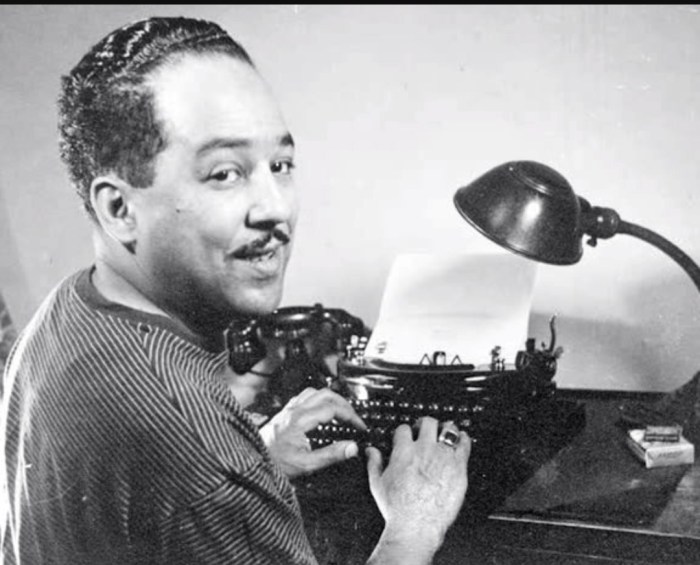Harlem by langston hughes questions and answers – Welcome to a comprehensive exploration of Langston Hughes’ renowned poem, “Harlem.” Dive into its historical context, literary devices, themes, symbolism, impact, and educational significance through a series of insightful questions and answers. Get ready to uncover the depths of this iconic work and gain a deeper appreciation for its enduring relevance.
Harlem by Langston Hughes: Historical Context

During the Harlem Renaissance, Harlem, a neighborhood in Manhattan, New York City, experienced a flourishing of African American art and culture. The neighborhood became a hub for writers, artists, musicians, and intellectuals, who sought to express their experiences and perspectives in the face of racial discrimination and segregation.
The cultural and social significance of Harlem during this period cannot be overstated. It was a place where African Americans could celebrate their heritage and create a sense of community. It was also a place where they could challenge racial stereotypes and fight for their rights.
Harlem Renaissance and Langston Hughes
Langston Hughes was one of the most prominent figures of the Harlem Renaissance. His poem “Harlem” captures the spirit and energy of the neighborhood during this time.
Harlem by Langston Hughes: Literary Analysis

Hughes’s poem “Harlem” is a sonnet, consisting of 14 lines written in iambic pentameter. The poem’s structure and rhythm contribute to its powerful and memorable impact.
The poem’s imagery is also striking. Hughes uses vivid language to paint a picture of Harlem’s vibrant streets and the dreams and aspirations of its people.
Literary Devices
- Metaphor:“A dream deferred” is a metaphor for the unfulfilled hopes and aspirations of African Americans.
- Simile:“Like a raisin in the sun” compares the deferred dream to a raisin that has dried up and lost its vitality.
- Anaphora:The repetition of “What happens to a dream deferred?” at the beginning of three consecutive lines emphasizes the urgency and importance of the question.
Harlem by Langston Hughes: Themes and Symbolism

“Harlem” explores several important themes, including:
- The deferred dream:The poem examines the consequences of unfulfilled dreams and aspirations, particularly for African Americans who faced systemic racism and discrimination.
- The resilience of the human spirit:Despite the challenges they faced, the people of Harlem remained hopeful and determined to achieve their dreams.
- The importance of community:Harlem was a place where African Americans could find support and solidarity in the face of adversity.
Hughes also uses several symbols in the poem, including:
- The dream:The dream represents the hopes and aspirations of African Americans.
- The raisin:The raisin symbolizes the deferred dream, which has become dry and lifeless.
- The sun:The sun symbolizes hope and the possibility of renewal.
Harlem by Langston Hughes: Impact and Legacy
“Harlem” had a profound impact on the Harlem Renaissance and beyond. The poem helped to raise awareness of the challenges faced by African Americans and inspired a new generation of writers and activists.
The poem continues to resonate with readers today, as it speaks to the universal themes of hope, disappointment, and the human spirit’s ability to overcome adversity.
Recognition and Influence, Harlem by langston hughes questions and answers
- The poem is widely anthologized and studied in schools and universities.
- It has been translated into numerous languages.
- It has inspired other works of art, including music, dance, and visual art.
Harlem by Langston Hughes: Critical Perspectives
There are various critical interpretations of “Harlem.” Some critics focus on the poem’s political and social significance, while others emphasize its literary qualities.
Some common critical perspectives include:
- Marxist criticism:This perspective examines the poem in the context of class struggle and economic inequality.
- Feminist criticism:This perspective explores the poem’s portrayal of gender and the experiences of African American women.
- Formalist criticism:This perspective focuses on the poem’s structure, language, and imagery.
Harlem by Langston Hughes: Educational Resources: Harlem By Langston Hughes Questions And Answers

Lesson Plan for High School English Class
Objectives:
- Students will be able to analyze the literary devices and techniques used in “Harlem.”
- Students will be able to identify and discuss the major themes of the poem.
- Students will be able to explain the impact and legacy of “Harlem” on the Harlem Renaissance and beyond.
Activities:
- Read the poem aloud as a class.
- Discuss the poem’s structure, rhythm, and imagery.
- Identify the major themes of the poem.
- Discuss the impact and legacy of the poem.
Online Resources
| Resource | Description |
|---|---|
| Academy of American Poets | Text of the poem, biography of Langston Hughes, and critical essays |
| Library of Congress | Manuscript of the poem in Hughes’s handwriting |
| Encyclopedia Britannica | Article on the poem, its historical context, and its literary significance |
Answers to Common Questions
What is the central theme of “Harlem”?
The poem explores the deferred dreams and aspirations of African Americans living in Harlem during the Harlem Renaissance.
How does Hughes use literary devices in the poem?
Hughes employs vivid imagery, metaphors, and repetition to create a powerful and evocative poetic experience.
What is the significance of the “dream deferred” metaphor?
The metaphor symbolizes the unfulfilled potential and stifled aspirations of African Americans in the face of racial inequality and discrimination.
How has “Harlem” influenced the Harlem Renaissance and beyond?
The poem became a rallying cry for the Harlem Renaissance, inspiring other artists and activists to express their experiences and advocate for social change.
What are some critical interpretations of “Harlem”?
Critics have interpreted the poem as a reflection of the Harlem Renaissance, a critique of racial inequality, and a celebration of African American resilience.